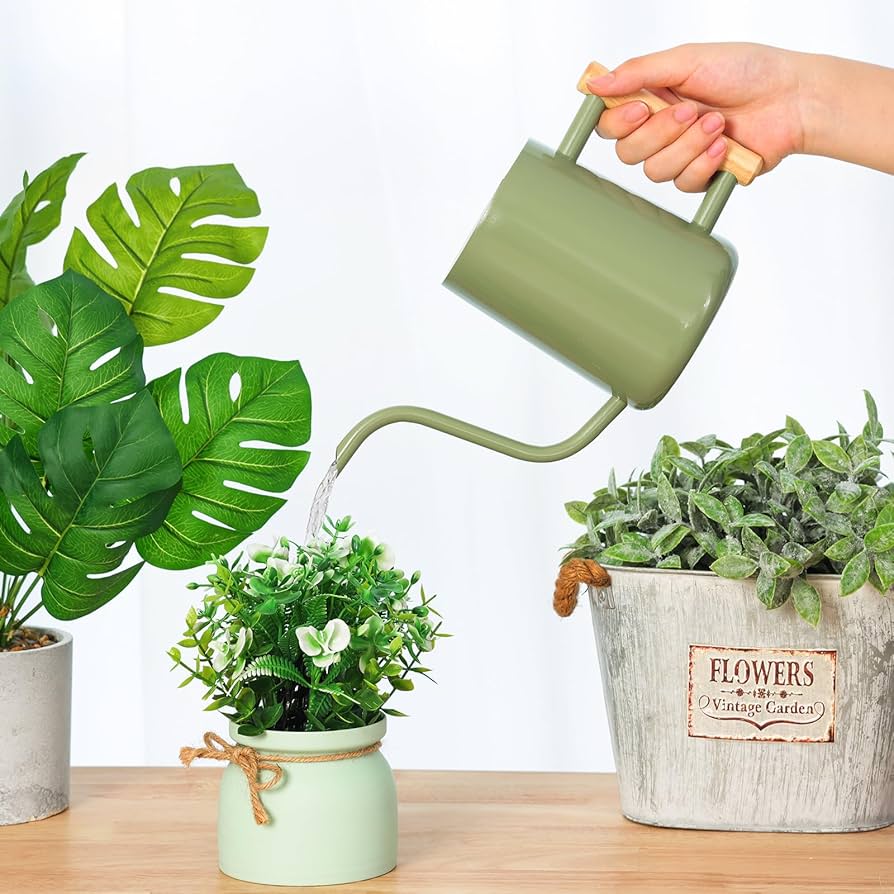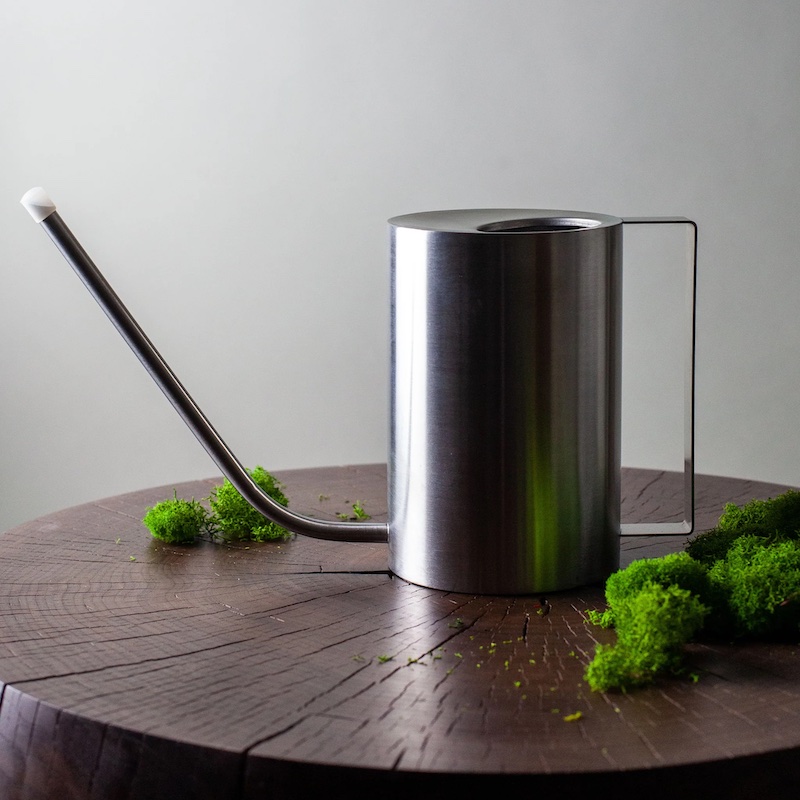The Importance of Proper Watering for House Plants
For house plants, proper watering is vital. It ensures they thrive. Each plant’s needs are different. Too much water can lead to root rot. Too little can cause wilting and stunt growth. The right house plant watering can helps prevent these issues. It allows for precision and control. This is important for the health of house plants. Watering needs vary throughout the year. In growing seasons, plants often need more water. In dormant periods, they need less. Using the correct watering can is key. It supports plant health regardless of the season. Remember, a healthy plant with proper watering is more resistant to pests and diseases. A good watering routine combines the right amount of water, timing, and an efficient watering can.
Key Features of an Efficient Watering Can
When looking for an efficient house plant watering can, certain features stand out as essential. Here are a few key aspects to consider:
- Capacity: The size of the watering can impacts how often you’ll need to refill it. For smaller plants or indoor use, a can with a capacity of 1 to 2 liters typically suffices.
- Material: Watering cans come in various materials. Plastic and metal are common. Each has its pros and cons relating to weight and durability.
- Spout design: A long, narrow spout provides precision. It allows for targeted watering, reducing spills and overwatering. Look for spouts with a detachable rose to simulate gentle rainfall.
- Handle comfort: An ergonomic handle reduces hand fatigue. This is crucial when you have multiple plants to water.
- Balance and weight: When full, a watering can should be easy to tip and pour without straining your wrist or arm.
- Visibility of water level: Some cans have a transparent stripe or a gauge. This helps you know how much water is left and can prevent overfilling.
By focusing on these key features, you’ll ensure your house plants receive the right amount of water consistently and efficiently. Adequate research before purchasing can lead to better care for your indoor garden.
Top Watering Can Designs for Different Types of House Plants
Finding the ideal house plant watering can design is essential for the wellbeing of your plants. Different types have distinct features that meet specific needs. Here are some of the top designs that cater to various house plant types:
- Indoor Pouring Cans: These cans are perfect for small indoor plants. They usually have a capacity of 1-2 liters and a precise spout for targeted watering.
- Outdoor Watering Cans: Designed for outdoor use, these cans are larger. Their capacity typically ranges from 5-10 liters. A strong handle supports the heavier weight when full.
- Cans with Detachable Roses: Ideal for plants that need gentle watering. The detachable rose simulates soft rain. This is great for seedlings and delicate foliage.
- Long-Spout Cans: With their extended reach, these cans can water hanging or distant plants with ease. The long spout offers accuracy, essential for crowded plant areas.
- Novelty Watering Cans: These come in fun shapes and colors, adding a decorative touch. While they may not be the most practical, they are suitable for light watering tasks.
- Professional Grade Cans: For the serious indoor gardener, these cans have all the top features. Durable materials, ergonomic design, and capacity options make them a strong choice.
No matter your plant type, there is a house plant watering can design out there to meet your watering needs. Ensure you match the can’s design with your indoor garden’s requirements for efficient and effective plant care.
How to Choose the Right Size Watering Can for Your Indoor Garden
Choosing the right size watering can for your indoor garden is a crucial decision. The size directly affects how often you’ll need to refill and how well you can manage watering tasks. Consideration of the following points will assist in making the best choice:
- Plant Quantity: If you have many house plants, a larger watering can may be better. It lets you water multiple plants before refilling.
- Plant Size: Small plants or seedlings require less water. A smaller watering can provide the right amount without waste.
- Space Constraints: Less room means storing a large watering can might be tough. Compact cans are easy to store and manage in tight spaces.
- Watering Frequency: Some house plants need water more often than others. For frequent watering, a mid-sized can might strike the right balance between capacity and manageability.
- Physical Ability: Consider your comfort when lifting and carrying. A can that’s too heavy when full can be hard to handle, especially for seniors or those with physical limitations.
Select a house plant watering can that fits the needs of your indoor garden without making the task burdensome. A well-chosen watering can will enable you to take care of your plants with ease and promote their growth and health.
Innovative Watering Can Materials and Durability
Choosing a house plant watering can with the right material is crucial. Material choice impacts not just durability but also usability and longevity. Let’s dive into the innovative materials available for watering cans and their durability benefits.
Plastic Watering Cans
Plastic as a material is lightweight and versatile. Modern plastics are also quite durable. They won’t rust like metal cans can over time. Moreover, they come in various colors and designs. This adds a personal touch to gardening tools. But, sunlight can weaken some plastics, so it’s best to store them away from direct exposure.
Metal Watering Cans
Metal watering cans are known for their strength. Galvanized steel or copper are common choices. They offer a classic look along with a sturdy feel. Metals can handle the wear and tear of gardening. Yet, they may be heavier, and without proper care, they can corrode. To prevent rust, store metal cans in a dry place.
Stainless Steel Watering Cans
Stainless steel offers a sleek and modern appearance. It’s resistant to rust and very robust. These cans can last for years if maintained well. They are often heavier than plastic but remain a durable option. The weight needs consideration, especially when full of water.
Rubber Watering Cans
Rubber is an unusual but functional choice. It’s tough and can withstand drops and rough handling. Rubber watering cans often have a good grip and flexibility. However, they can be heavier and might not suit everyone’s needs.
Recycled Materials
Eco-friendly options are becoming popular. Watering cans made from recycled materials support sustainability. They often blend durability with a lighter environmental footprint. Such materials may include recycled plastics or metals. These choices show care not only for plants but also for the planet.
When selecting a house plant watering can, consider these innovative materials. Think about how each one aligns with your gardening needs and values. Durability ensures your watering can stands the test of time, protecting your investment and supporting your passion for house plants.
Ergonomic Watering Cans for Ease of Use
An ergonomic house plant watering can is key for comfort. It should feel good in your hand. A well-designed handle is a must. It should let you grip without strain. Such cans help you water plants with ease. A lightweight can reduces fatigue during long watering sessions.
Look for cans with curved handles for a natural hold. Also, consider a can’s balance. A well-balanced can makes lifting and pouring simpler. You want a can that is easy to tilt without spilling. This makes watering house plants less of a chore.
An ergonomic can often has a contoured design. This fits better against your body when carrying. It makes moving between plants smooth and easy. Choose a can that brings ease to your gardening. This way, taking care of your indoor plants is both effective and comfortable.
Watering Can Care and Maintenance Tips
To keep your house plant watering can in top shape, follow these simple care and maintenance tips:
- Regular Cleaning: After each use, rinse your watering can to prevent sediment buildup. Wipe it dry to avoid water spots and rust.
- Proper Storage: Store your watering can in a shaded, dry place. This protects it from weather damage and extends its lifespan.
- Inspect for Damage: Check for leaks, dents, or nozzle clogs. Fix them promptly to maintain efficiency.
- Handle With Care: Use your watering can as intended. Avoid dropping it or using it as a stool.
- Periodic Deep Cleaning: Occasionally, clean the inside with a brush. Vinegar or soapy water can remove dirt or mineral deposits.
Careful attention to these tips will ensure your house plant watering can stays functional. This helps make watering easier and your plants happier.
Recommended Watering Techniques for Healthy House Plants
Healthy house plants need more than just a good watering can. They also require proper watering techniques. Here are tips for keeping your plants hydrated and happy:
- Check Soil Moisture: Before watering, feel the soil. If it’s dry an inch below the surface, it’s time to water.
- Water Deeply: Ensure water reaches the roots. Water slowly so the soil absorbs it, rather than letting it run off.
- Avoid Wetting Leaves: Try not to splash the leaves. Wet leaves can encourage fungal diseases.
- Morning Watering: Water plants in the morning. This lets the water absorb before the heat of the day minimizes evaporation.
- Use Room Temperature Water: Cold water can shock plants. Let tap water sit out until it reaches room temperature.
- Know Your Plants: Different plants have different needs. Learn each plant’s preferences for the best care.
By following these techniques with a suitable house plant watering can, your indoor garden will flourish. Remember, consistent care leads to healthy, long-living plants.


